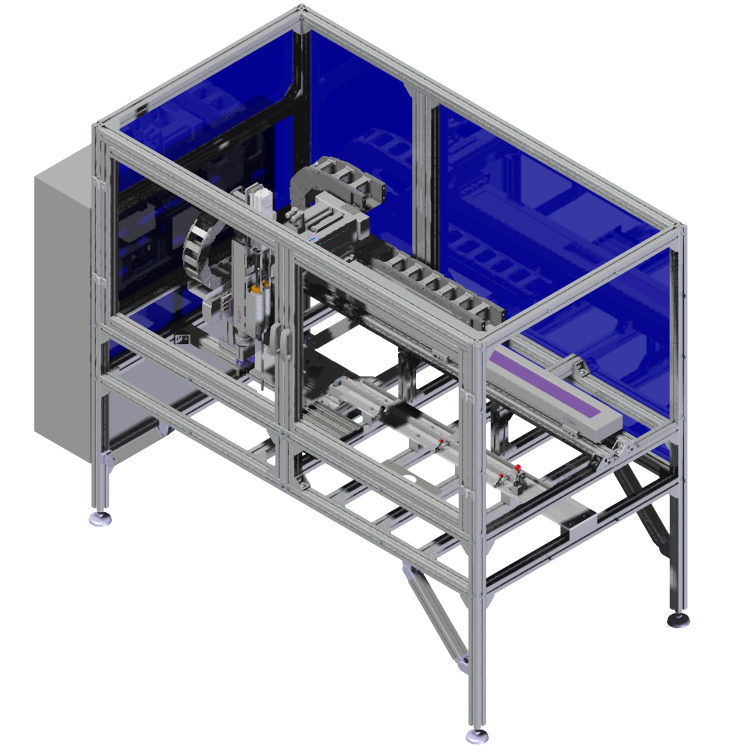2012 /2013
Klebeautomatisierung
Jahrgang
Projektpartner
Röchling Leripa Papertech GmbH & Co. KG
Maturanten

Schmid Alexander
5BAT

Silber Martin
5BAT
Betreuer

Stockinger Thomas
Problemstellung
Derzeit werden die Entwässerungsleisten für Papiermaschinen bei der Firma Röchling Leripa Papertech per Hand gefertigt. Da vor allem der Klebstoff nicht gerade gesund für den menschlichen Körper ist, soll dieser Vorgang teilautomatisiert werden.
Zielsetzung
Ziel ist es eine Maschine zu konstruieren und zu bauen, welche den Prozess zum fertigen der Entwässerungsleisten automatisiert. Es wurde mit der Firma beschlossen, dass in diesem Jahr nur ein Prototyp gebaut wird, welcher als Grundlage für eine eventuelle Weiterentwicklung dienen soll.
Projektablauf
Beginn mit der Projektphase, Überlegen von möglichen mechanischen Lösungen
Durchführung von Versuchen
Festlegung des Konzepts/ der mechanischen Lösung
Beginn mit der Konstruktion, Zeichnen einer 3D- Konstruktion am Computer
Mechanische Fertigung in der schuleigenen Werkstatt.
Beginn mit der Montage und der Elektroinstallation
Programmieren der Steuerung und schreiben der Dokumentation
Ergebnis
Der fertige Prototyp konnte 17.05.2013 dem Auftraggeber übergeben werden und arbeitet seither zufriedenstellend.
Verwertbarkeit
Die gefertigte Anlage dient als Grundlage für den Bau einer Maschine zum Fertigen von Entwässerungsleisten mit einer Länge von maximal 12m. Dabei wird der Prototyp verwendet, um Versuche durchzuführen, die bei der Konstruktion der kompletten Anlage wichtig sein könnten.
Systembeschreibung
Die Keramiksegmente werden durch einen Mitarbeiter in das Magazin gegeben. Von dort aus werden sie vom Portalroboter entnommen. Zuvor wird per Hand der GFK-Stab in das Profil gelegt und gespreizt, um eine Einführöffnung zu erzeugen. Das Portal fädelt die Segmente nun auf das Grundprofil auf. Zwischen Begrenzungssegment und dem 1. Segment wird eine Segmentlänge frei gelassen und hier der Klebstoff aufgetragen. Danach wird das Segment leicht angehoben und über die Klebefläche geschoben und verklebt. Dabei einsteht wiederum ein Spalt von ca. einer Segmentlänge, wobei der Klebevorgang erneut durchgeführt wird, bis alle Segmente verklebt worden sind.
Presentation of the problem
In the last few years the drainage strips of paper machines were made by hand by the employees of the company Röchling Leripa Papertech. Because of the unhealthiness of the glue, this process should be automated.
Objectives
The result is to construct and build a machine which is able to produce these drainage strips automatically. The agreement with the company is that we only should build a prototype this year. So this machine is a basic concept for the next developing stage.
Project schedule
conceptualisation and possible solutions
doing trials for instance about the force for putting in the GFK- rods
decision for the best concept
start with the CAD
production
assembling and the electrical installation
programming and documentary
Results:
The finished machine is delivered to Leripa on May 17, 2013 and does work without any problems.
Usability
The prototype was built, to have a basis for constructing of the whole machine, which is able to produce drainage strips with a length of 12m
Description
The workers take the ceramic segment and put them into the magazine. A gripper takes the ceramic segments from the magazine and threads it on the basic profile. Before that, the GFK- rod is put into the profile and then the rod will be spreaded. Between the first and the second segment should be a distance by the length of one segment. On this distance, the glue is plotted on the profile and finally the gripper takes the segment again and presses it on the glued surface. This process is repeated till the end of the profile.


